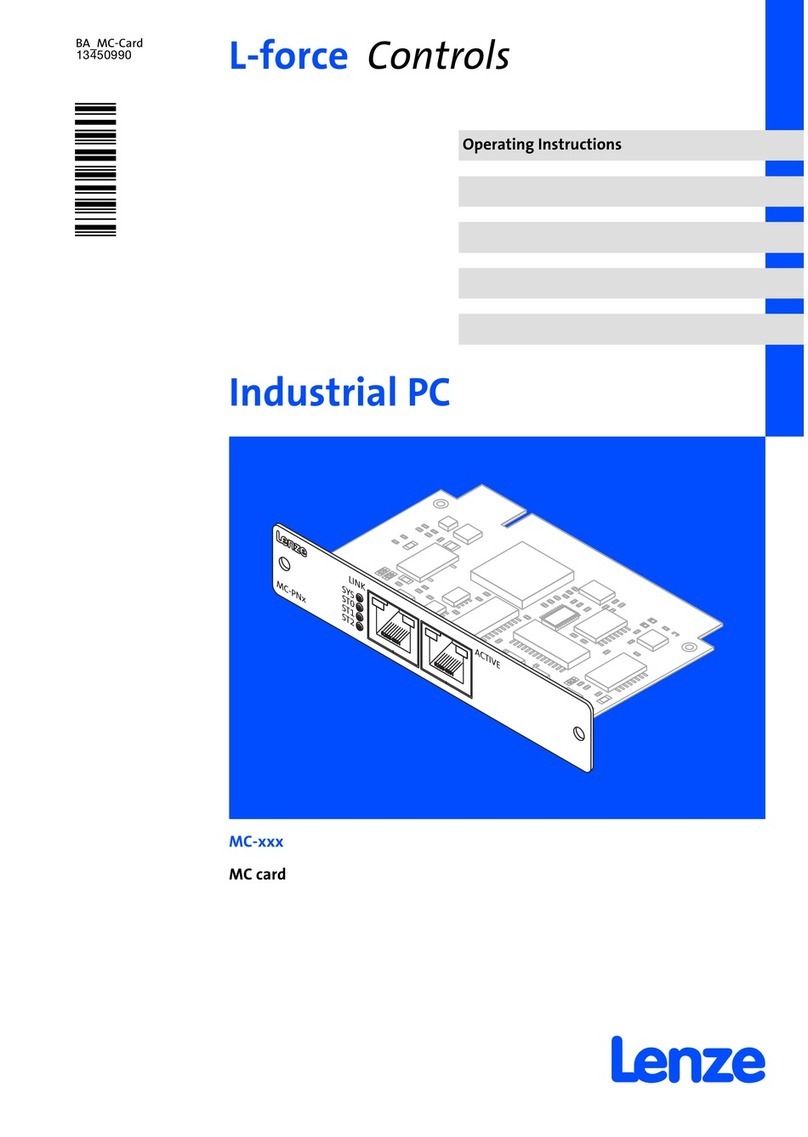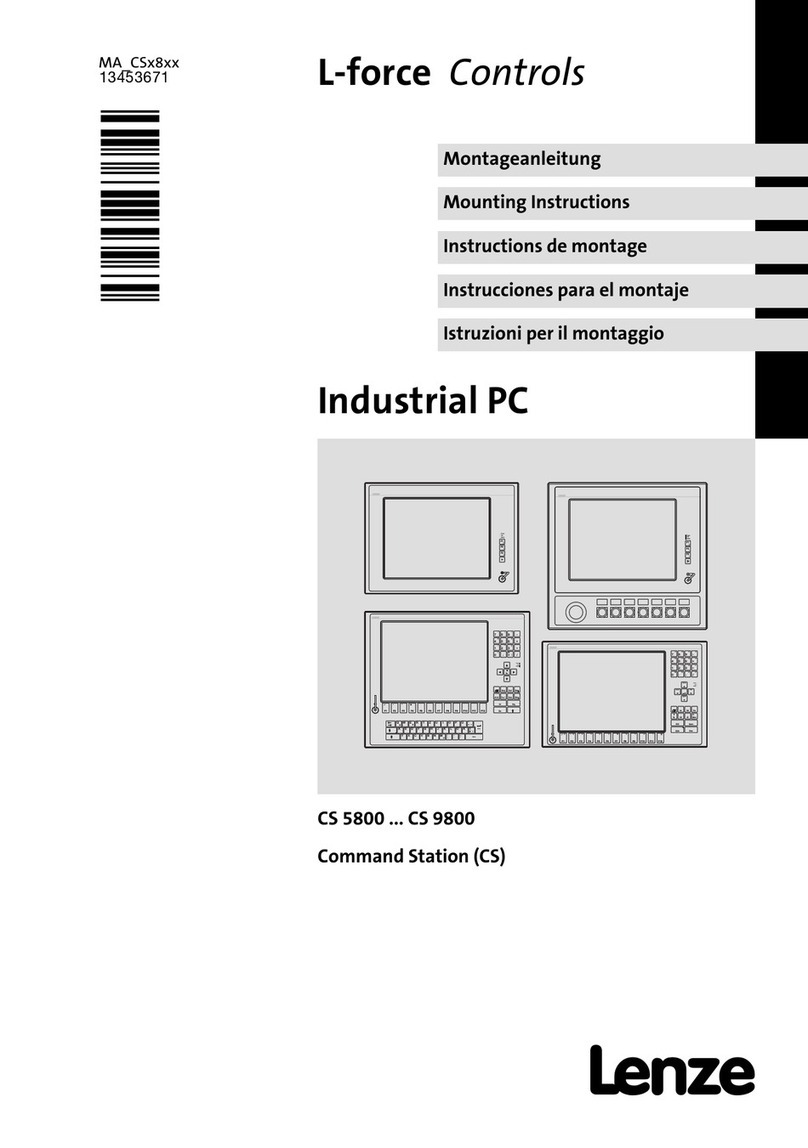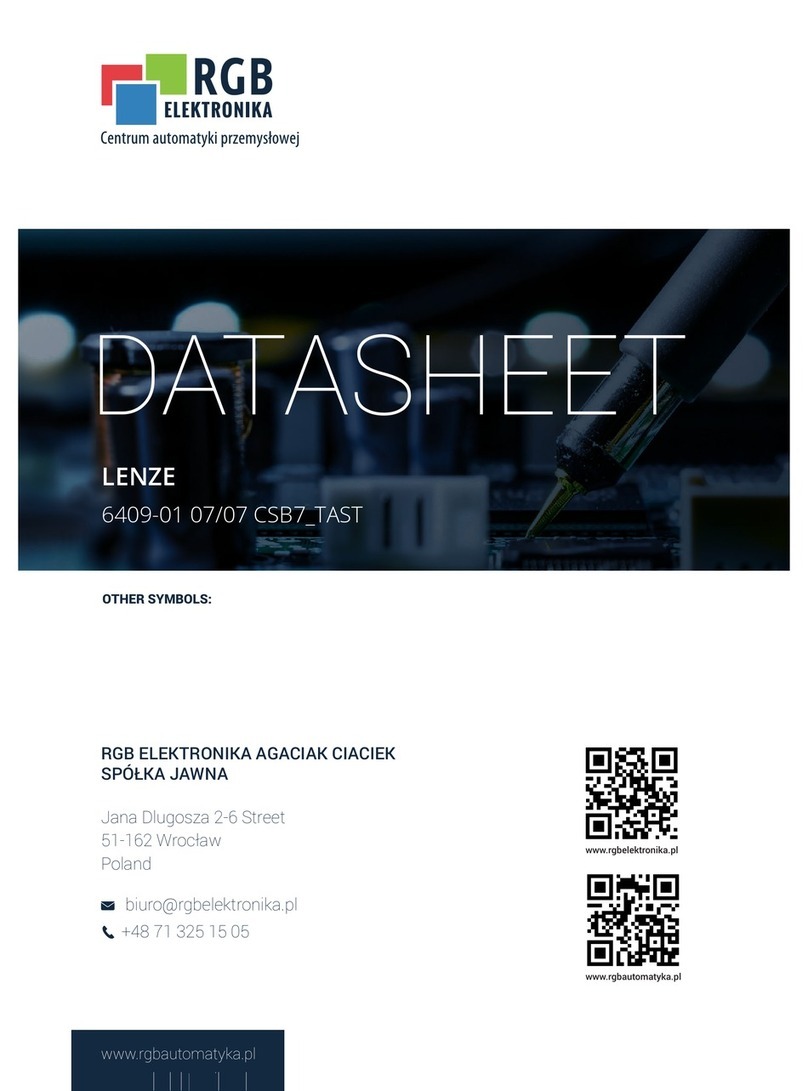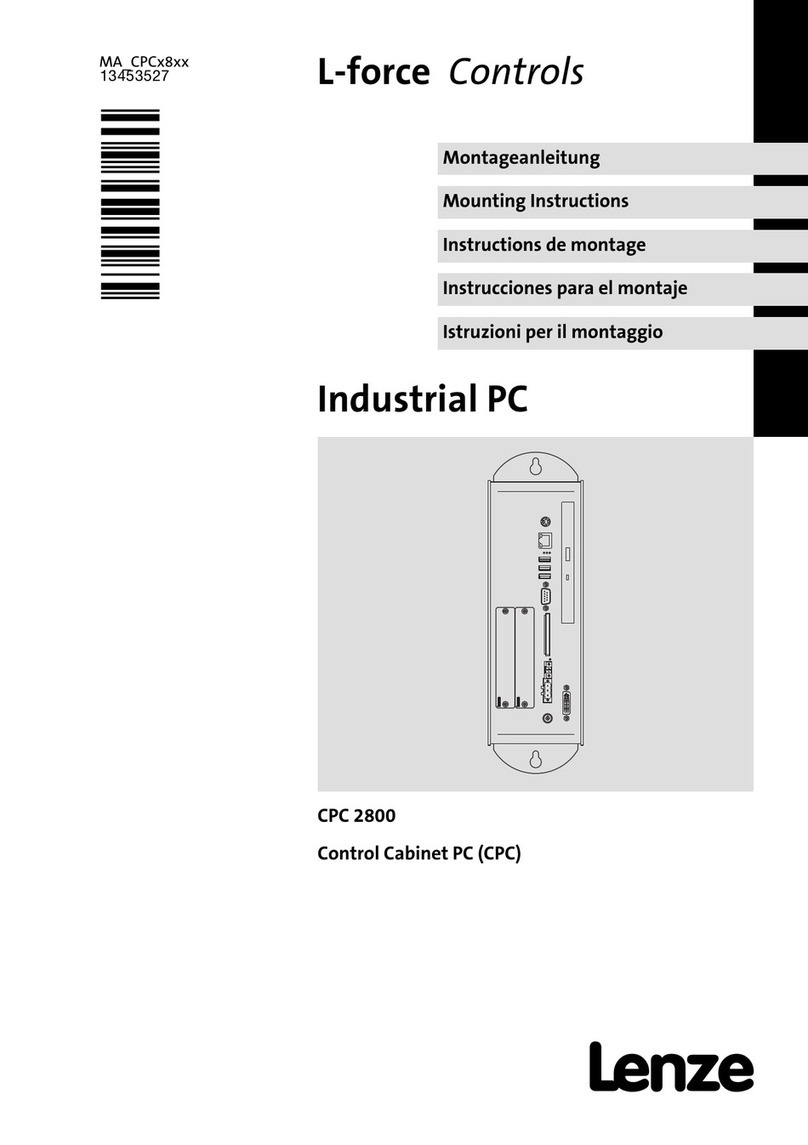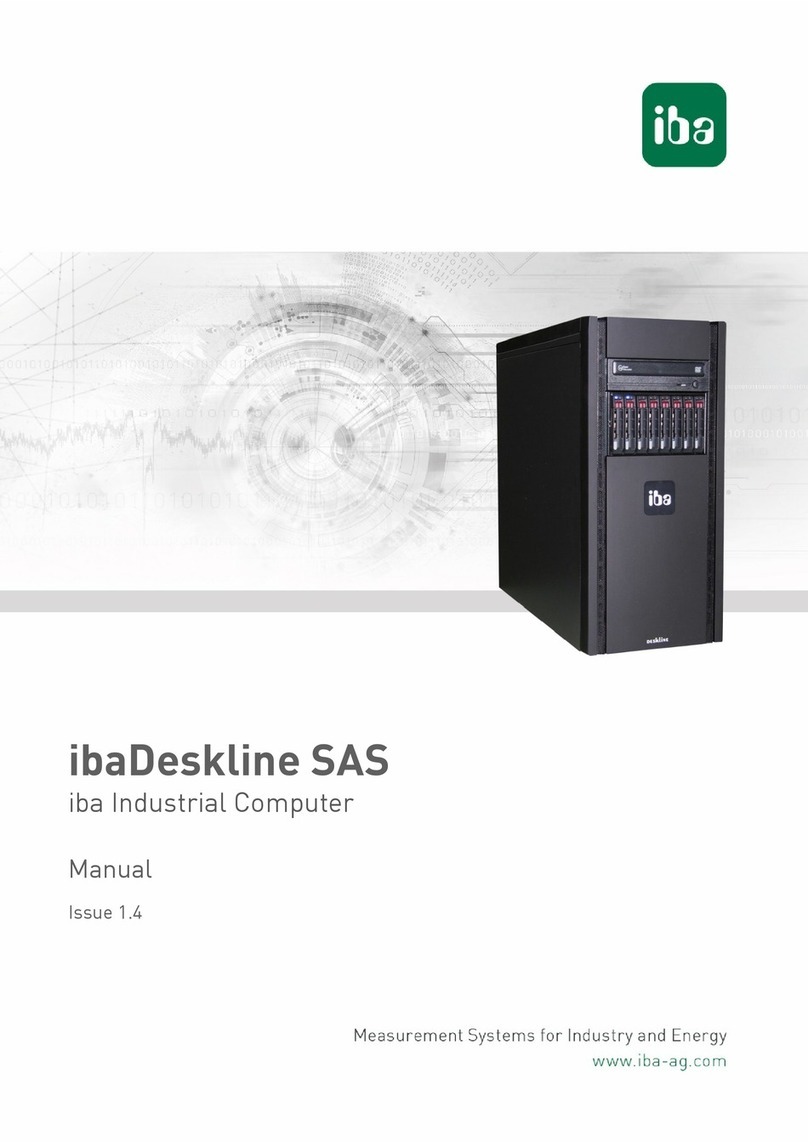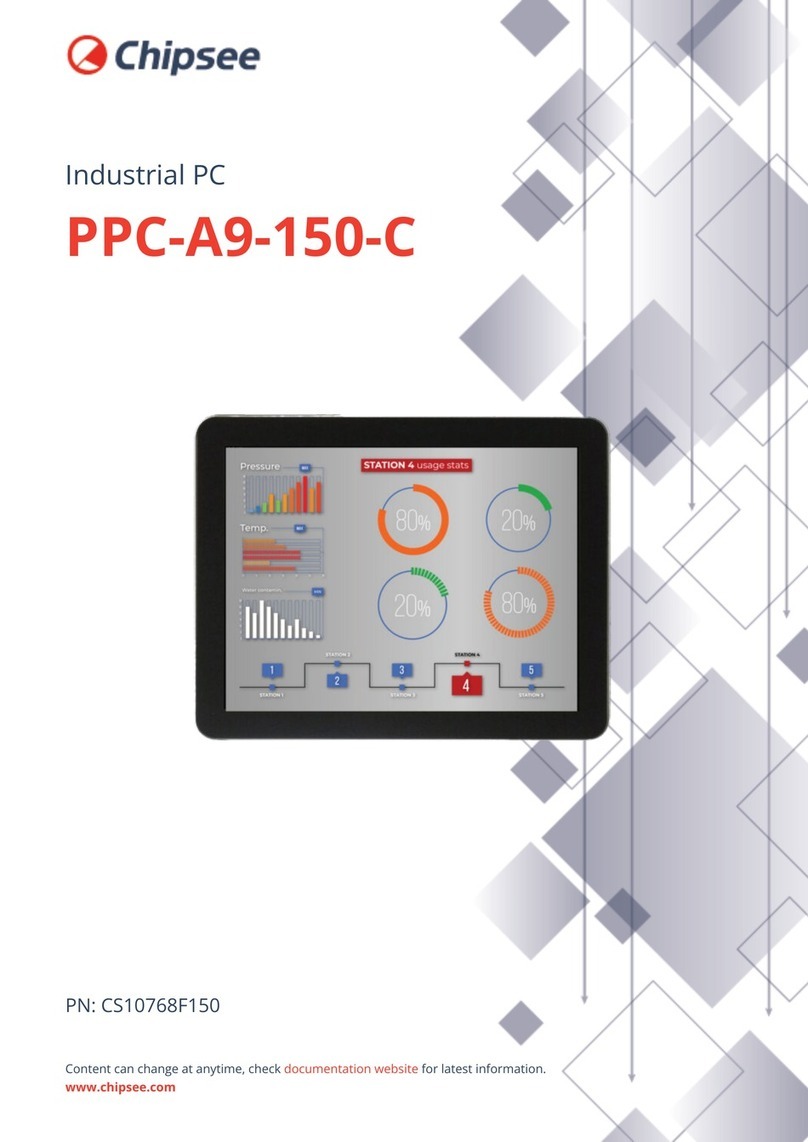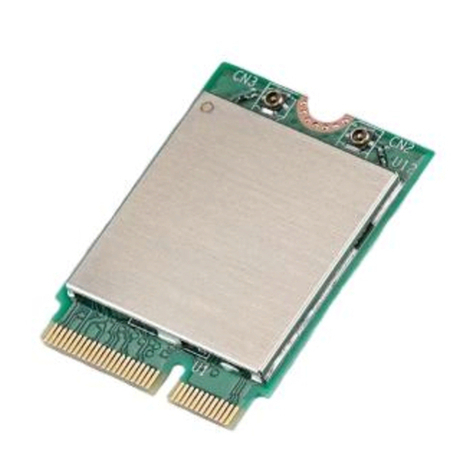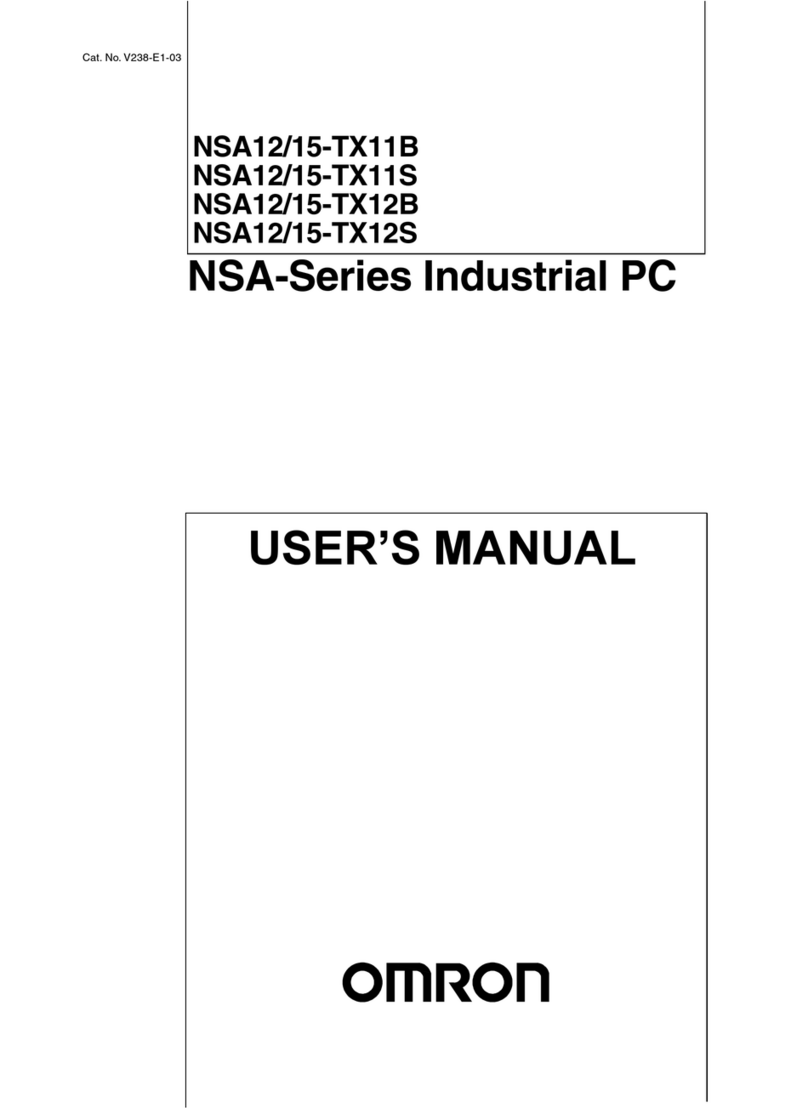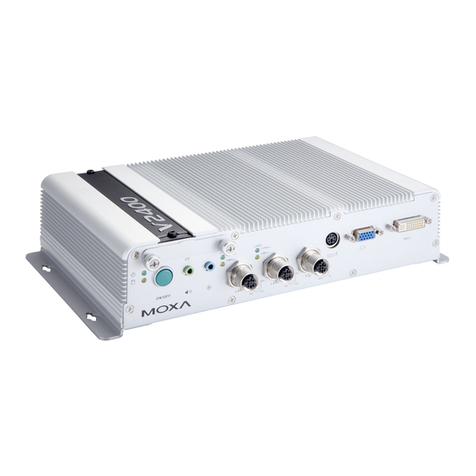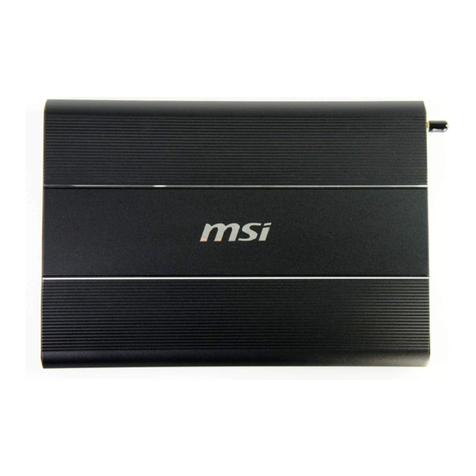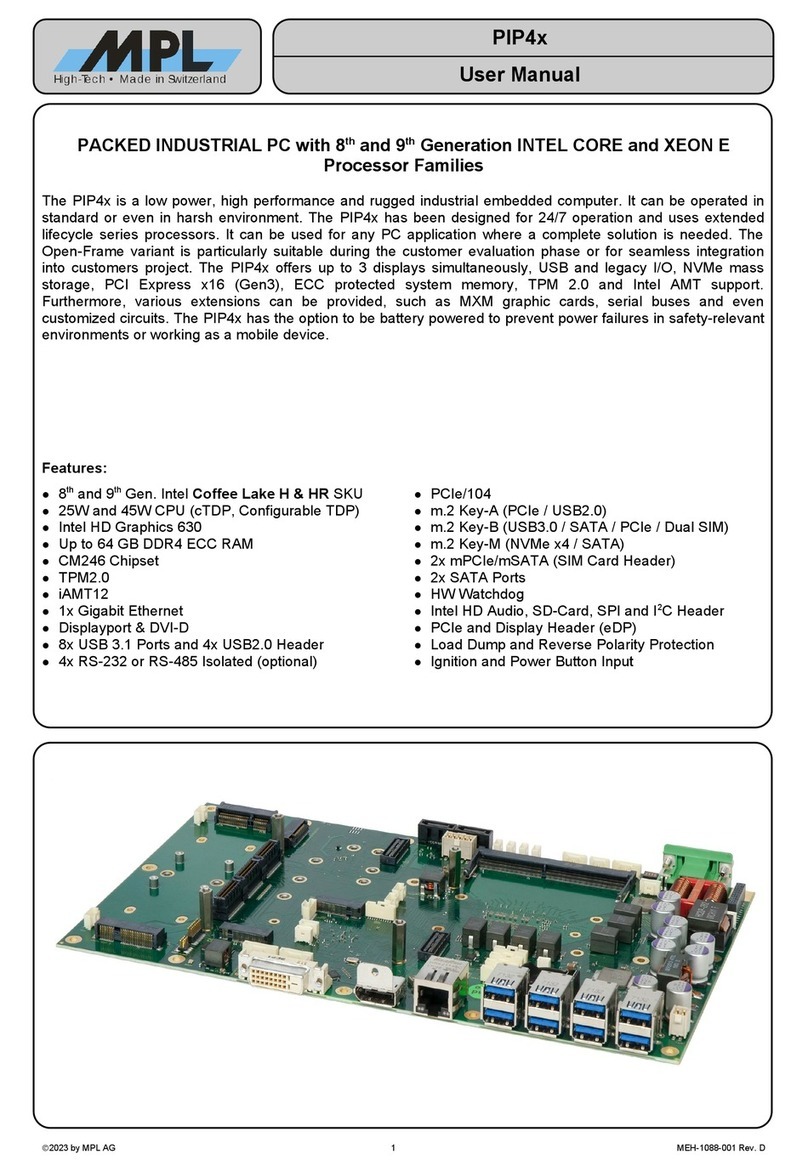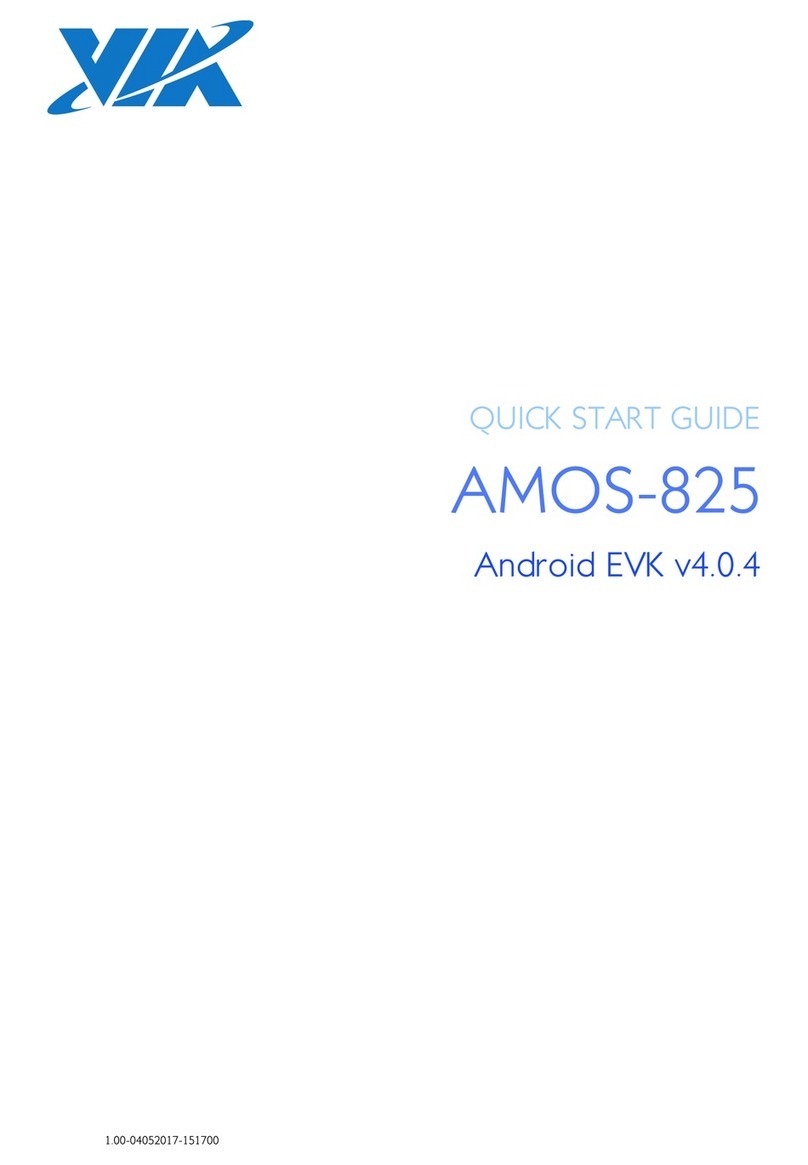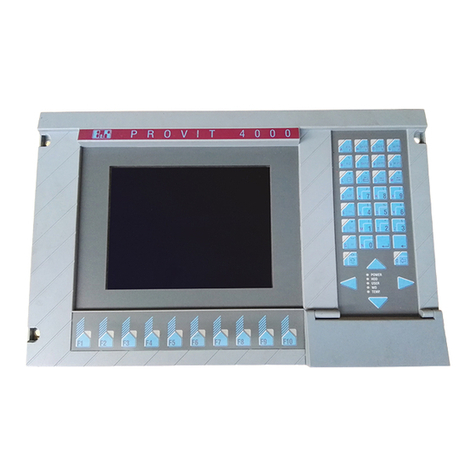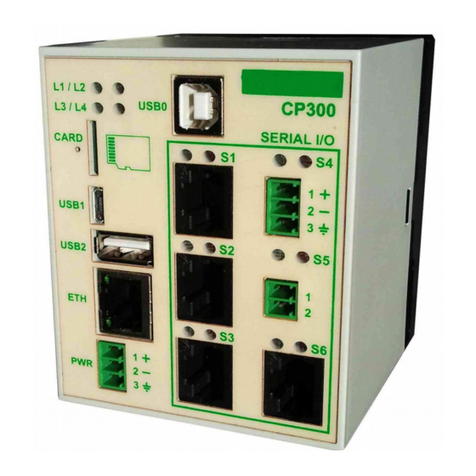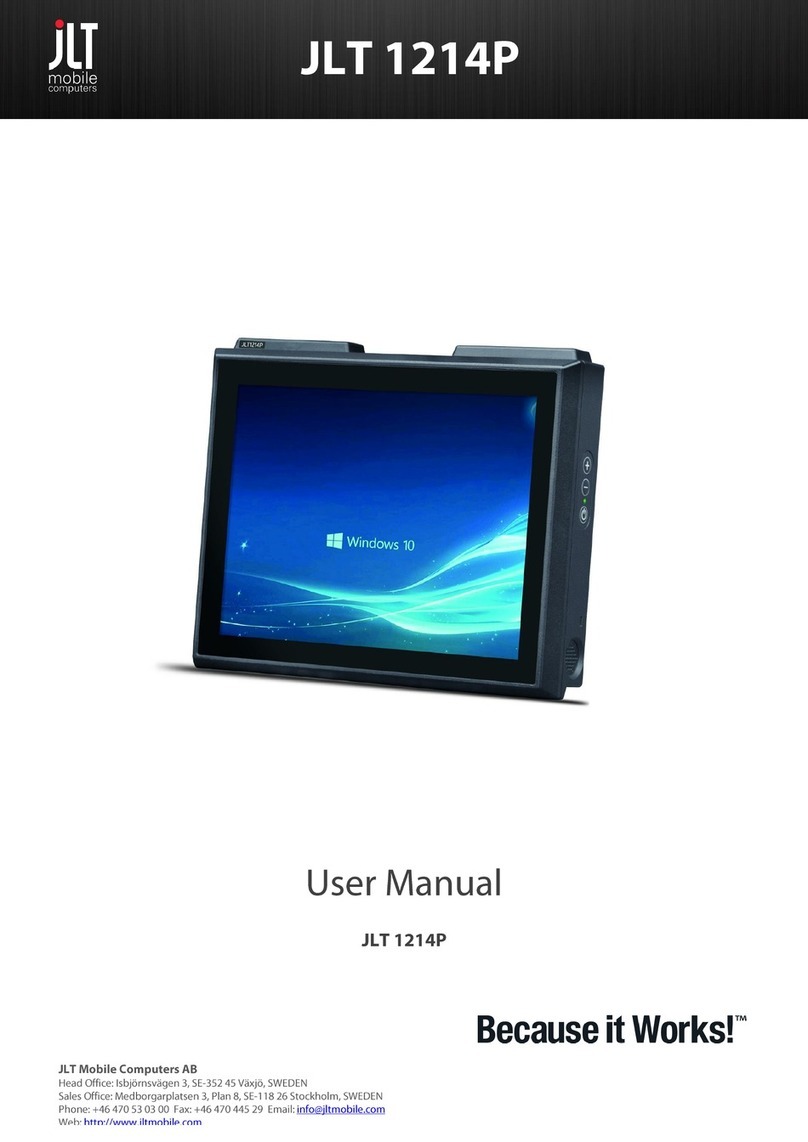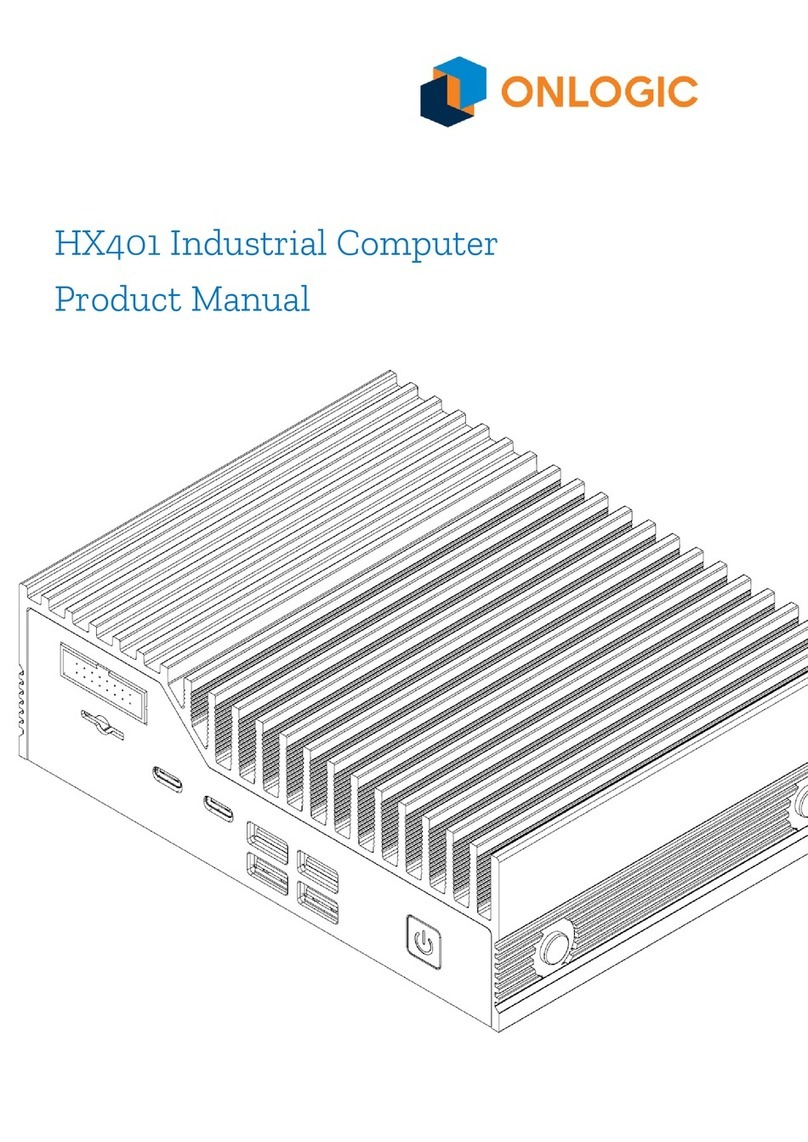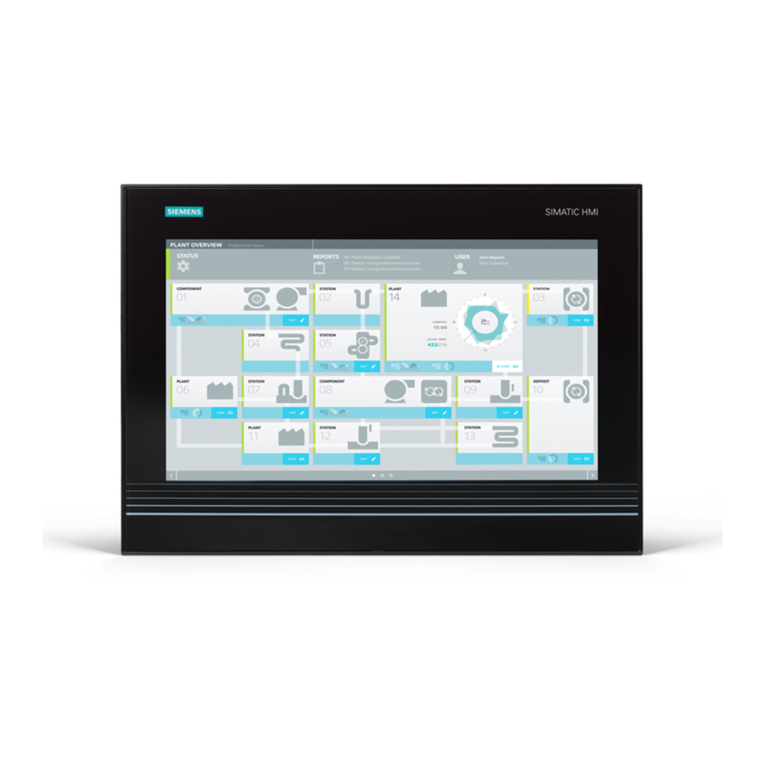Lenze EL 1800 User guide

EDSIPCx7
.N+_
Ä.N+_ä
System Manual
Industrial PC
l
Embedded Line (EL), Command Station (CS), Cabinet PC (CPC), L−force
Controller 3241 C
System structure and configuration
L−force Controls

0Fig. 0Tab. 0

Contents i
l3
EDSIPCx7 EN 4.1
1 About this documentation 4. . . . . . . . . . . . . . . . . . . . . . . . . . . . . . . . . . . . . . . . . . . . . . . . . .
1.1 Document history 4. . . . . . . . . . . . . . . . . . . . . . . . . . . . . . . . . . . . . . . . . . . . . . . . . . . .
1.2 Conventions used 5. . . . . . . . . . . . . . . . . . . . . . . . . . . . . . . . . . . . . . . . . . . . . . . . . . . .
1.3 Terminology used 5. . . . . . . . . . . . . . . . . . . . . . . . . . . . . . . . . . . . . . . . . . . . . . . . . . . .
1.4 Notes used 6. . . . . . . . . . . . . . . . . . . . . . . . . . . . . . . . . . . . . . . . . . . . . . . . . . . . . . . . . .
2 Safety instructions 7. . . . . . . . . . . . . . . . . . . . . . . . . . . . . . . . . . . . . . . . . . . . . . . . . . . . . . . . .
2.1 General safety information 7. . . . . . . . . . . . . . . . . . . . . . . . . . . . . . . . . . . . . . . . . . . .
3 Product description 10. . . . . . . . . . . . . . . . . . . . . . . . . . . . . . . . . . . . . . . . . . . . . . . . . . . . . . . .
3.1 Application as directed 10. . . . . . . . . . . . . . . . . . . . . . . . . . . . . . . . . . . . . . . . . . . . . . .
3.2 "Industrial PC" system 11. . . . . . . . . . . . . . . . . . . . . . . . . . . . . . . . . . . . . . . . . . . . . . . .
3.3 Overview of designs 14. . . . . . . . . . . . . . . . . . . . . . . . . . . . . . . . . . . . . . . . . . . . . . . . . .
3.3.1 Embedded Line 15. . . . . . . . . . . . . . . . . . . . . . . . . . . . . . . . . . . . . . . . . . . . . .
3.3.2 Command Station 16. . . . . . . . . . . . . . . . . . . . . . . . . . . . . . . . . . . . . . . . . . . .
3.3.3 Cabinet PC 17. . . . . . . . . . . . . . . . . . . . . . . . . . . . . . . . . . . . . . . . . . . . . . . . . . .
3.4 Embedded Line (EL, MP) design 18. . . . . . . . . . . . . . . . . . . . . . . . . . . . . . . . . . . . . . . . .
3.5 Command Station (CS) design 20. . . . . . . . . . . . . . . . . . . . . . . . . . . . . . . . . . . . . . . . . .
3.6 Cabinet PC (CPC) design 23. . . . . . . . . . . . . . . . . . . . . . . . . . . . . . . . . . . . . . . . . . . . . . .
3.6.1 3241 C 23. . . . . . . . . . . . . . . . . . . . . . . . . . . . . . . . . . . . . . . . . . . . . . . . . . . . . .
3.6.2 CPC 2800 25. . . . . . . . . . . . . . . . . . . . . . . . . . . . . . . . . . . . . . . . . . . . . . . . . . .
3.6.3 CPC 5100 26. . . . . . . . . . . . . . . . . . . . . . . . . . . . . . . . . . . . . . . . . . . . . . . . . . .
3.6.4 CPC 9100 27. . . . . . . . . . . . . . . . . . . . . . . . . . . . . . . . . . . . . . . . . . . . . . . . . . .
3.7 Options 28. . . . . . . . . . . . . . . . . . . . . . . . . . . . . . . . . . . . . . . . . . . . . . . . . . . . . . . . . . . . .
3.7.1 Overview 28. . . . . . . . . . . . . . . . . . . . . . . . . . . . . . . . . . . . . . . . . . . . . . . . . . . .
3.7.2 ACU UPS control unit 28. . . . . . . . . . . . . . . . . . . . . . . . . . . . . . . . . . . . . . . . . .
3.8 Accessories 29. . . . . . . . . . . . . . . . . . . . . . . . . . . . . . . . . . . . . . . . . . . . . . . . . . . . . . . . . .
3.8.1 Overview 29. . . . . . . . . . . . . . . . . . . . . . . . . . . . . . . . . . . . . . . . . . . . . . . . . . . .
3.9 Software 30. . . . . . . . . . . . . . . . . . . . . . . . . . . . . . . . . . . . . . . . . . . . . . . . . . . . . . . . . . . .
3.9.1 Operating system (accessories) 30. . . . . . . . . . . . . . . . . . . . . . . . . . . . . . . . .
3.9.2 Other software types 30. . . . . . . . . . . . . . . . . . . . . . . . . . . . . . . . . . . . . . . . . .
3.9.3 Fan monitoring with "Smart Cool" and "FAN Service" (option) 31. . . . . . .
4 Index 32. . . . . . . . . . . . . . . . . . . . . . . . . . . . . . . . . . . . . . . . . . . . . . . . . . . . . . . . . . . . . . . . . . . .

About this documentation
Document history
1
l
4 EDSIPCx7 EN 4.1
1 About this documentation
Contents
This documentation provides you with information about the intended use of the
Industrial PC.
The present manual is part of the "PC−based automation" manual collection which you can
find on the DVDs of the same name.
Target group
This documentation is directed at qualified skilled personnel according to IEC 60364.
Qualified skilled personnel are persons who have the required qualifications to carry out
all activities involved in installing, mounting, commissioning, and operating the product.
Validity
These instructions are valid for
ƒEmbedded Line EL 1800 − EL 9800 (TC)
ƒMonitor Panel MP 800 − 9000 DVI
ƒCommand Station CS 5800 − 9800 (TC)
ƒCommand Station CS 5000 − 9000 DVI
ƒCabinet PC CPC 2800, CPC 5100, CPC 9100
ƒCabinet PC 3241 C
1.1 Document history
Material number Version Description
.N+_ 4.1 11/2013 TD29 Description of MC cards moved in separate
operating instruction
13433000 4.0 03/2013 TD29 General revision
13370131 3.0 02/2011 TD29 Amended by description of MC−ISI communication
card
13348653 2.0 10/2010 TD31 Change of generation from x700 series to x800
series
13300002 1.0 06/2009 TD14 First edition
ITip!
Information and auxiliary devices related to the Lenze products can be found
in the download area at
http://www.Lenze.com

About this documentation
Conventions used
1
l5
EDSIPCx7 EN 4.1
1.2 Conventions used
This documentation uses the following conventions to distinguish between different
types of information:
Spelling of numbers
Decimal separator Point In general, the decimal point is used.
For instance: 1234.56
Text
Program name » « PC software
For example: »Engineer«, »Global Drive
Control« (GDC)
Icons
Page reference ^Reference to another page with additional
information
For instance: ^16 = see page 16
Documentation reference ,Reference to another documentation with
additional information
For example: ,EDKxxx = see
documentation EDKxxx
1.3 Terminology used
Term Meaning
IPC Industrial PC
CPC Cabinet PC; control cabinet PC with decentralised
display/operating unit (MP, Thin Client)
CS Command Station; stand−alone operator station
EL Embedded Line PC; for installation in control cabinets, machine
panelling, or other mounting cutouts
MP Monitor panel; external display
Thin Client Device for representing and operating applications which are
located on a remote host computer (e.g. CPC).
PLC Programmable Logic Controller

About this documentation
Notes used
1
l
6 EDSIPCx7 EN 4.1
1.4 Notes used
The following pictographs and signal words are used in this documentation to indicate
dangers and important information:
Safety instructions
Structure of safety instructions:
}Danger!
(characterises the type and severity of danger)
Note
(describes the danger and gives information about how to prevent dangerous
situations)
Pictograph and signal word Meaning
{Danger!
Danger of personal injury through dangerous electrical voltage.
Reference to an imminent danger that may result in death or
serious personal injury if the corresponding measures are not
taken.
}Danger!
Danger of personal injury through a general source of danger.
Reference to an imminent danger that may result in death or
serious personal injury if the corresponding measures are not
taken.
(Stop!
Danger of property damage.
Reference to a possible danger that may result in property
damage if the corresponding measures are not taken.
Application notes
Pictograph and signal word Meaning
)Note! Important note to ensure troublefree operation
ITip! Useful tip for simple handling
,Reference to another documentation

Safety instructions
General safety information
2
l7
EDSIPCx7 EN 4.1
2 Safety instructions
2.1 General safety information
Scope
The following general safety instructions apply to all Lenze drive and automation
components.
The product−specific safety and application notes given in this documentation must be
observed!
For your own safety
}Danger!
Disregarding the following basic safety measures may lead to severe personal
injury and damage to material assets!
ƒLenze drive and automation components ...
... must only be used for the intended purpose.
... must never be operated if damaged.
... must never be subjected to technical modifications.
... must never be operated unless completely assembled.
... must never be operated without the covers/guards.
... can − depending on their degree of protection − have live, movable or rotating parts
during or after operation. Surfaces can be hot.
ƒAll specifications of the corresponding enclosed documentation must be observed.
This is vital for a safe and trouble−free operation and for achieving the specified product
features.
The procedural notes and circuit details provided in this document are proposals which
the user must check for suitability for his application. The manufacturer does not
accept any liability for the suitability of the specified procedures and circuit proposals.
ƒOnly qualified skilled personnel are permitted to work with or on Lenze drive and
automation components.
According to IEC 60364 or CENELEC HD 384, these are persons ...
... who are familiar with the installation, assembly, commissioning and operation of
the product,
... possess the appropriate qualifications for their work,
... and are acquainted with and can apply all the accident prevent regulations, directives
and laws applicable at the place of use.
Transport, storage
ƒTransport and storage in a dry, low−vibration environment without aggressive
atmosphere; preferably in the packaging provided by the manufacturer.
– Protect against dust and shocks.
– Comply with climatic conditions according to the technical data.

Safety instructions
General safety information
2
l
8 EDSIPCx7 EN 4.1
Mechanical installation
ƒInstall the product according to the regulations of the corresponding
documentation. In particular observe the section "Operating conditions" in the
chapter "Technical data".
ƒProvide for a careful handling and avoid mechanical overload. During handling
neither bend components, nor change the insulation distances.
ƒThe product contains electrostatic sensitive devices which can easily be damaged by
short circuit or static discharge (ESD). Thus, electronic components and contacts
must not be touched unless ESD measures are taken beforehand.
Electrical installation
ƒCarry out the electrical installation according to the relevant regulations (e. g. cable
cross−sections, fusing, connection to the PE conductor). Additional notes are
included in the documentation.
ƒWhen working on live products, observe the applicable national regulations for the
prevention of accidents (e.g. BGV 3).
ƒThe documentation contains notes for the EMC−compliant installation (shielding,
earthing, arrangement of filters and installation of the cables). The manufacturer of
the system or machine is responsible for the compliance with the limit values
required in connection with EMC legislation.
ƒFor compliance with the limit values for radio interference emission at the site of
installation, the components − if specified in the technical data − have to be mounted
in housings (e. g. control cabinets). The housings have to enable an EMC−compliant
installation. In particular observe that for example control cabinet doors preferably
have a circumferential metallic connection to the housing. Reduce openings or
cutouts through the housing to a minimum.
ƒOnly plug in or remove pluggable terminals in the deenergised state!
Commissioning
ƒIf required, you have to equip the system with additional monitoring and protective
devices in accordance with the respective valid safety regulations (e. g. law on
technical equipment, regulations for the prevention of accidents).
Maintenance and servicing
ƒThe components are maintenance−free if the required operating conditions are
observed.
ƒIf the cooling air is polluted, the cooling surfaces may be contaminated or the air
vents may be blocked. Under these operating conditions, the cooling surfaces and air
vents must be cleaned at regular intervals. Never use sharp objects for this purpose!
ƒAfter the system has been disconnected from the supply voltage, live components
and power connections must not be touched immediately because capacitors may
be charged. Please observe the corresponding notes on the device.

Safety instructions
General safety information
2
l9
EDSIPCx7 EN 4.1
Disposal
ƒRecycle metals and plastic materials. Ensure professional disposal of assembled
PCBs.
ƒThis device contains a battery. According to European legislation you are obliged to
dispose of batteries separately via the take−back systems specified.

Product description
Application as directed
3
l
10 EDSIPCx7 EN 4.1
3 Product description
3.1 Application as directed
Lenze Industrial PCs (IPCs) are used as directed if they are exclusively used for the
implementation of operator concepts or the presentation of information in common
industrial and commercial areas. A different use, or one beyond these purposes, is not
permissible.
A use that is not intended also includes a use harbouring fatal risks or dangers which,
without the provision of exceptionally high safety measures, may result in death, injury or
damage to material assets.
Lenze Industrial PCs must not be used ...
ƒin private areas.
ƒin potentially explosive atmospheres.
ƒin areas with harmful gases, oils, acids, radiation, etc.
ƒin applications where vibration and impact loads occur, exceeding the requirements
of EN 50178.
ƒfor performing safety functions, for instance
– in air traffic control / in flight−control systems
– for the monitoring/control of nuclear reactions
– for the monitoring/control of means of mass transport
– for the monitoring/control of medical systems
– for the monitoring/control of weapon systems
Higher−level safety systems must be used to guarantee the protection of persons and
material assets!

Product description
"Industrial PC" system
3
l11
EDSIPCx7 EN 4.1
3.2 "Industrial PC" system
The "Industrial PC" system by Lenze offers a broad platform for the creation of devices
configured in a customised manner providing corresponding hardware components for
the respective application case. For the corresponding hardware components like CPU,
ROM, RAM, etc. please refer to the current IPC catalogue.
According to the requirements of the customer application, the operator devices can be
selected from a variety of possibilities (screen size/operator panels). The consistently
implemented platform strategy with defined interfaces with regard to electronics and
mechanics allows for various combinations of the modules. Like this, the suitable system
can be implemented for virtually every application.
Apart from the standard devices there is a number of accessory components which provide
for the integration of the individually adapted Industrial PC into a variety of different
system environments.
For the Industrial PCs as component also the following complete automation systems are
offered:
ƒControl technology
Logic & Motion with CANopen and EtherCAT (^"Control technology" system manual)
ƒVisualisation technology
Scalable visualisation system with CANopen, PROFIBUS, PROFINET, and Ethernet (^
"Visualisation technology" system manual)
The IPC platform is complemented by cost−optimised HMIs which are offered in fixed
configurations and which, to a limited extent, also perform automation functions. This
EL100 series is designed for the installation in control cabinet doors and is solely different
with regard to the design of the touch−sensitive touchscreen (see operating instructions
for the HMI EL100/EL100−ECO).

Product description
"Industrial PC" system
3
l
12 EDSIPCx7 EN 4.1
Centralised and decentralised solutions
Depending on the requirements with regard to the installation of the Industrial PC, both
centralised Panel PC solutions and decentralised (separate) solutions can be selected.
Centralised solutions:The Panel PCs of the "Embedded Line (EL)" and "Command Station
(CS)" series are compact devices and combine display, operation, and electronics in a
common housing.
Fig. 3−1 Centralised Panel PC solution
Decentralised solutions:The decentralised solutions comprise separate units: the
Industrial PC of the "Cabinet PC (CPC)" series, which is preferably placed in a protected
manner in the control cabinet, and the operating unit on site (monitor panel MP or CS−DVI).
This solution has advantages with regard to cabling, operating conditions, and
accessibility.
Fig. 3−2 Decentralised Panel PC solution

Product description
"Industrial PC" system
3
l13
EDSIPCx7 EN 4.1
Customised solutions
Different industry sectors and ambient conditions bring about extremely differing
requirements with regard to the design of IPCs and operator panels, which due to their
complexity cannot always be implemented by means of standard components. In these
cases Lenze is the solution partner for customised developments.
Typical developments are:
ƒCustomised decoration foil for a consistent Corporate Design
ƒExtension with components (mouse−pad, RFID, speakers, scanner,)
ƒIndividual software adaptations
ƒStainless steel operator devices with minimised clearances in IP65, IP66 or IP69K.

Product description
Overview of designs
3
l
14 EDSIPCx7 EN 4.1
3.3 Overview of designs
By a consequently implemented platform strategy Industrial PCs can be individually
assembled and nearly optionally scaled with regard to power, display size, and function. By
this, three different designs are provided from which the customised platform for the
automation solution can be selected in each case.
In the Embedded Line and Command Station types apart from the Industrial PCs also Thin
Clients (EL 1800 − 9800 TC, CS 5800 − 9800 TC) and monitor panels (MP 800 − 9000 DVI,
CS 5000 − 9000 DVI) are available.
Design Embedded Line Command Station Cabinet PC Cabinet PC
Type EL 1800 − 9800
EL 1800 − 9800 TC
MP 800 − 9000 DVI
CS 5800 − 9800
CS 5800 − 9800 TC
CS 5000 − 9000 DVI
CPC 2800
CPC 5100
CPC 9100
3241 C
Mounting /
installation
In mounting cutout
of machine
panelling / control
cabinets
Stand−alone on a support
arm or wall
In the control
cabinet on a wall
In the control
cabinet on DIN rail
Enclosure Front: IP65, rear
side: IP20
IP65 IP20 IP20
Screen TFT display with touch sensors Externally Externally
26.4 cm ... 48.3 cm
(10.4" ... 19")
38.1 cm ... 48.3 cm
(15" ... 19")
Product benefits lCompact,
mechanically
robust panel PC
lFanless
operation is
possible as an
option
lDecentralised
design possible
lExpansible via
MC card
lStand−alone, robust,
command station
protected against dust
and splash water to all
sides
lFlat design housing
with rear mounting
frame
lSupport arm mounting
or wall mounting
lDecentralised design
possible
lExpansible via MC card
lCompact,
mechanically
robust control
cabinet PC
lDecentralised
design
lExpansible via
MC card
lCompact,
mechanically
robust control
cabinet PC
lDecentralised
design
lExpansible via
MC card
lExpansible via
I/O compound
modules

Product description
Overview of designs
Embedded Line
3
l15
EDSIPCx7 EN 4.1
3.3.1 Embedded Line
Industrial PCs of the "Embedded Line (EL)" type are panel PCs for the installation in control
cabinets, machine panelling, or other mounting cutouts. They are provided with bolts and
clamping screws on the rear side for easy mounting and a safe sealing also in rough
industrial environments.
Apart from the Industrial PCs 1800 − EL 9800, also mere displays (monitor panels and Thin
Clients) are available in this design, which can be connected as a monitor to a Cabinet PC.
Thin Clients (TC): A Thin Client terminal serves to represent and operate applications on a
remotely installed host computer via a network connection. For data transmission the
Microsoft® RDP (Remote Desktop Protocol) is used. As host computer a Windows® XP
system for an operating section or a Windows® server operating system for several
operating sections is used. All processes are carried out on the connected server, the Thin
Client only providing for the display of the graphics or of the input systems for operating
the application. The computing power of the client can therefore be kept accordingly low.
Monitor panel (MP): A monitor panel is an operator terminal to use remote Industrial PCs
as a built−in variant or stand−alone terminal. Like the Embedded Line devices, they feature
corresponding front modules.
Type EL 1800 − 9800 EL 1800 − 9800 TC MP 800 − 9000 DVI
Function IPC Thin Client Monitor panel
Screen diagonal 26.4 cm (10.4"), 30.5 cm (12.1"), 38.1 cm (15") or
48.3 cm (19" inches)
20.3 cm (8"), 26.4 cm
(10.4"), 30.5 cm (12.1"),
38.1 cm (15") or 48.3 cm
(19" inches)
Current supply DC24 V ±25%
Uninterruptible power
system (UPS) Optionally via ACU UPS control unit −
Cooling With or without fan Without fan
MC card slots 2 2 −
MC card ^29 − −
Configurable Yes No No
Interfaces
3 x USB type A
1 x USB type A front panel (opt.)
1 x PS/2
1 x RS232
1 x LAN (10/100 Mbps)
2 x USB type A
1 x USB type A front panel
(opt.)
1 x USB type B
1 x DVI
Enclosure
Front
Rear side
IP65
IP20
Backup
If Windows®CE 6.0 is
used: backup and restore
tool V2
− −

Product description
Overview of designs
Command Station
3
l
16 EDSIPCx7 EN 4.1
3.3.2 Command Station
A Command Station (CS) is a stand−alone operator station which is protected against dust
and splash water at each side. The flat housing features a mounting frame on the rear side,
which can be mounted on a support arm or a wall. For the flexible implementation of
individual operating concepts the system offers numerous options and extension
consoles.
Apart from the Industrial PCs CS 5800 − 9800, also mere monitor panels and Thin Clients
are available in this design, which can be connected as a monitor to a Cabinet PC.
Thin Clients (TC): A Thin Client terminal serves to represent and operate applications on a
remotely installed host computer via a network connection. For data transmission the
Microsoft® RDP (Remote Desktop Protocol) is used. As host computer a Windows® XP
system for an operating section or a Windows® server operating system for several
operating sections is used. All processes are carried out on the connected server, the Thin
Client only providing for the display of the graphics or of the input systems for operating
the application. The computing power of the client can therefore be kept accordingly low.
Monitor panel (DVI): A monitor panel is an operator terminal to use remote Industrial PCs
as a built−in variant or stand−alone terminal. Like the command station devices, they
feature corresponding front modules and add−on components.
Type CS 5800 − 9800 CS 5800 − 9800 TC CS 5000 − 9000 DVI
Function IPC Thin Client Monitor panel
Screen diagonal 38.1 cm (15") or 48.3 cm (19")
Current supply DC 24 V ±25%
Uninterruptible power
system (UPS) Optionally via ACU UPS control unit −
Cooling With fan
MC card slots 1 1 −
MC card ^29 − −
Configurable Yes No No
Interfaces
3 x USB type A
1 x USB type A front panel (opt.)
1 x/2 x USB type A in mounting frame (opt.)
1 x PS/2
1 x RS232
1 x LAN (10/100 Mbps)
2 x USB type A
1 x USB type A front panel
(opt.)
1 x USB type B
1 x DVI
1 x LAN (10/100 Mbps)
Enclosure IP65
Backup
If Windows®CE 6.0 is
used: backup and restore
tool V2
− −

Product description
Overview of designs
Cabinet PC
3
l17
EDSIPCx7 EN 4.1
3.3.3 Cabinet PC
The decentralised solutions comprise separate units, the Industrial PC which is preferably
placed in a protected manner in the control cabinet, and the operating unit on site. This
solution has advantages with regard to cabling, operating conditions, and accessibility.
The following can be used as a screen:
ƒA standard monitor.
ƒA Monitor panel of the "Command Station" or "Embedded Line" type.
With the DVI/USB extender accessories the distance between the IPC and the monitor
panel can be up to 35 m.
ƒA Thin Client Panel of the "Command Station" or "Embedded Line" type for
representing and operating applications which are located on a remotely installed
host computer (IPC).
The Thin Client and host computer communicate via an Ethernet connection. Like this
greater distances can be covered than with an external monitor panel. Since all
processes run on the host computer and the Thin Client solely serves to display
information and to transfer entries, the CPU performance can be selected accordingly
low.
Type 3241 C CPC 2800 CPC 5100 CPC 9100
Function IPC
Current supply DC 24 V ±25% AC 115 V ... 230 V
Uninterruptible
power system (UPS) Optionally via ACU UPS control unit Optionally via UPS−331
Mounting Within control
cabinet on DIN rail Within control cabinet on a wall Within 19"
mounting rack
Cooling Without fan With or without fan With fan
MC card slots 1 2 −
MC card ^29 ^29 −
Configurable No Yes
Interfaces
3 x USB type A
1 x DVI (no VGA)
2 x LAN
(10/100 Mbps)
1 x LAN (1 Gbps)
3 x USB type A
1 x PS/2
1 x RS232
1 x DVI
1 x LAN
(10/100 Mbps)
8 x USB type A
2 x PS/2
1 x RS232
1 x DVI
2 x LAN
(10/100 Mbps)
10 x USB type A
2 x PS/2
1 x RS232
1 x DVI
2 x LAN
(10/100 Mbps)
Enclosure IP20 IP20 (front IP54)
Backup
If Windows®CE is
used: backup and
restore tool V3
If Windows®CE is
used: backup and
restore tool V2
RAID 0, 1, 5, 10

Product description
Embedded Line (EL, MP) design
3
l
18 EDSIPCx7 EN 4.1
3.4 Embedded Line (EL, MP) design
Elements
-
F3
Fail
Power
F1
+
F2
Status
10
0 1
7
6
3
2
4
8
PS/2
LAN
RS232
ACU UPS
24 V DC
CF Card
MC Card
Reset
USB
5
ELx7xx−001
Pos. Description
0Panel PC / Thin Client / monitor panel (here EL 5800 Panel PC)
1Front face USB port (option)
2Screw clamp fixings
3DVD drive (option); not for monitor panel (MP 800− 9000 DVI)
4PC or monitor control for the monitor panel (MP 800− 9000 DVI)
5Front face control and display elements
Overview
Panel PC EL EL 1800 / EL 1800s / EL 2800 / EL 5800 / EL 9800
Thin Client EL EL 1800 TC / EL 1800s TC / EL 2800 TC / EL 5800 TC / EL 9800 TC
Monitor Panel MP 800 DVI / MP 1000 DVI / MP 1000s DVI / MP 2000 DVI / MP 5000 DVI / MP 9000 DVI
-
F3
Fail
Power
F1
+
F2
Status
lEL 1800 (TC): VGA touchscreen 26.4 cm (10,4")
EL 1800s (TC): SVGA touchscreen 26.4 cm (10,4")
EL 2800 (TC): SVGA touchscreen 30.5 cm (12,1")
EL 5800 (TC): XGA touchscreen 38.1 cm (15")
EL 9800 (TC): SXGA touchscreen 48.3 cm (19")
lMP 800 DVI: VGA touchscreen 20.3 cm (8")
MP 10000 DVI: VGA touchscreen 26.4 cm (10,4")
MP 1000s0 DVI: SVGA touchscreen 26.4 cm (10,4")
MP 20000 DVI: SVGA touchscreen 30.5 cm (12,1")
MP 50000 DVI: XGA touchscreen 38.1 cm (15")
MP 90000 DVI: SXGA touchscreen 48.3 cm (19")
l3 freely assignable function keys
CS57x0−026

Product description
Embedded Line (EL, MP) design
3
l19
EDSIPCx7 EN 4.1
Panel PC EL 5820
Thin Client EL 5820 TC
Monitor Panel MP 5020 DVI
S13
S14
S11
S10
S12
S6
S7
F3F2
+
-
F4
Status
Power
Fail
F1
Esc Enter
F11 F12F6F5 F7 F8 F9 F10
S1
S4
S2
S3
S5
S8
S9
lXGA touchscreen 38.1 cm (15")
l12 freely assignable function keys
l14 freely assignable special keys
ELx7xx−002
Panel PC EL 1850 / EL 1850s / EL 2850 / EL 5850
Thin Client EL 1850 TC / EL 1850s TC / EL 2850 TC / EL 5850 TC
Monitor Panel MP 1050 DVI / MP 1050s DVI / MP 2050 DVI / MP 5050 DVI
Q+R
F1F2F5
-
ST
F3F4
@\Z
F11F10
YX
F9F8 F12
WVU
F7F6
Shift
Alpha
Bs
Space
Enter
EscDelIns
Menu
AltCtrl
Home
1
I
0
M
4
E
7
A
PgDn
*
3
JKL
/
,
NOP
PgUp
End
Status
Power
Fail
2
.
+6
FGH
-
9
BCD
5
8
lEL 1850 (TC): VGA touchscreen 26.4 cm (10.4")
EL 1750s (TC): SVGA touchscreen 26.4 cm (10.4")
EL 2850 (TC): SVGA touchscreen 30.5 cm (12.1")
EL 5850 (TC): XGA touchscreen 38.1 cm (15")
lMP 1050 DVI: VGA touchscreen 26.4 cm (10.4")
MP 1050s DVI: SVGA touchscreen 26.4 cm (10.4")
MP 2050 DVI: SVGA touchscreen 30.5 cm (12.1")
MP 5050 DVI: XGA touchscreen 38.1 cm (15")
l12 freely assignable function keys
lKeypad, control keys, Alpha level switch−over
CS57x0−028
Panel PC EL 5870
Thin Client EL 5870 TC
Monitor Panel MP 5070 DVI
"
(
§
&
)
=
/
$
!
>/
*
-
+
,
|
546
879
123
<
0
-
+
AltStrg
*
+
T
F4
€
D
EWQ
XY
SA
@
F3F1F2
R
VC
F
F5
GH J
-
_
Ä
F9F8F6 F7 F10
OI PÜUZ
Ö
;
,:
M
μ
.
LK
NB
Space
Enter
\
?
ß
~
F12
Esc
F11
Pos 1
Einfg
Ende
Entf
Bs
AltGr
Fail
Status
Power
Bild
Bild
lXGA touchscreen 38.1 cm (15")
l12 freely assignable function keys
lMF2 keyboard
CS57x0−029

Product description
Command Station (CS) design
3
l
20 EDSIPCx7 EN 4.1
3.5 Command Station (CS) design
Elements
Status
F1
Fail
+
-
F3
F2
Power
0
1
8
7
6
5
4
PS/2
LAN
RS232
ACU UPS
24 V DC
CF Card
MC Card
Reset
USB
23
9
CS57x0−001
Pos. Description
0Command Station (IPC, here CS 5800)
Command Station TC (Thin Client)
Command Station DVI (monitor panel)
1Mounting frame with VESA−100 adapter surface
2PC or monitor control for the monitor panel
3Screen
4Front face control and display elements
5Front face USB port (option)
6Mounting frame connecting plate (option)
Overview
Command Station CS 5800 / CS 9800
Command Station CS 5800 TC / CS 9800 TC
Command Station CS 5000 DVI / CS 9000 DVI
-
F3
Fail
Power
F1
+
F2
Status
lCS 5800 (TC): XGA touchscreen 38.1 cm (15")
CS 9800 (TC): SXGA touchscreen 48.3 cm (19")
lCS 5000 DVI: XGA touchscreen 38.1 cm (15")
CS 9000 DVI: SXGA touchscreen 48.3 cm (19")
l3 freely assignable function keys
CS57x0−026
Other manuals for EL 1800
2
This manual suits for next models
15
Table of contents
Other Lenze Industrial PC manuals

Lenze
Lenze EPCZEBED User manual
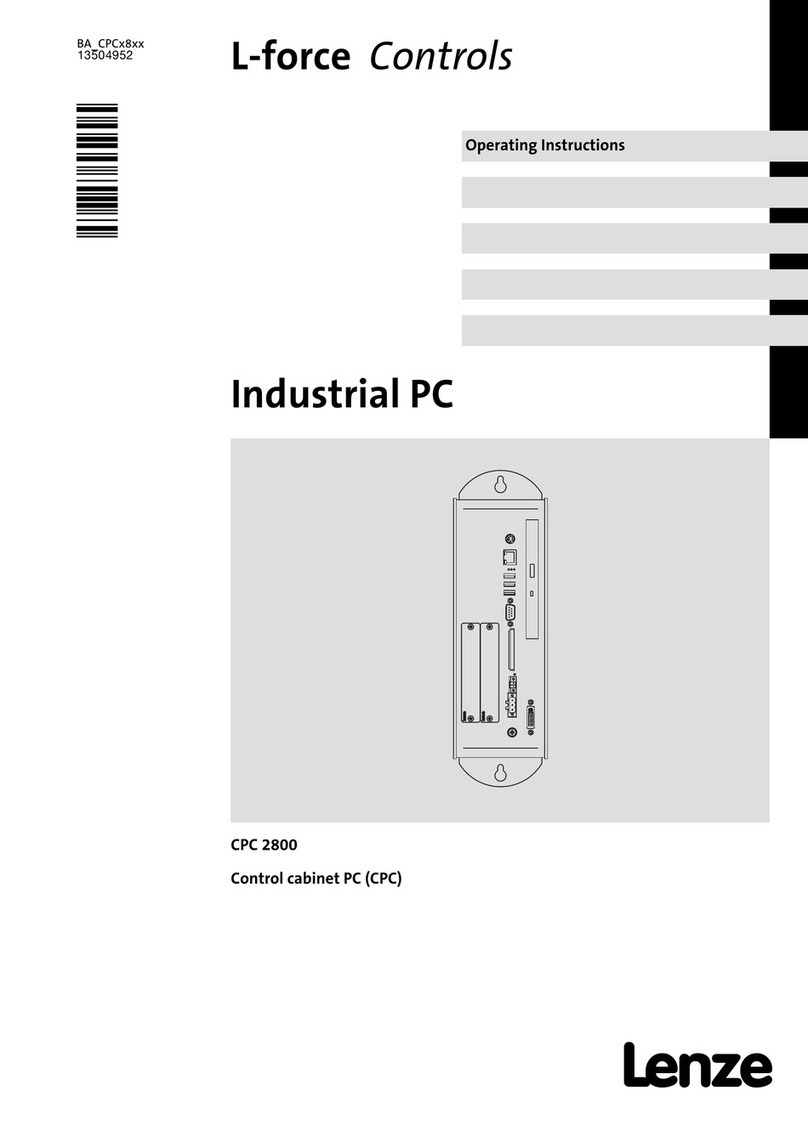
Lenze
Lenze L-force CPC 2800 User manual
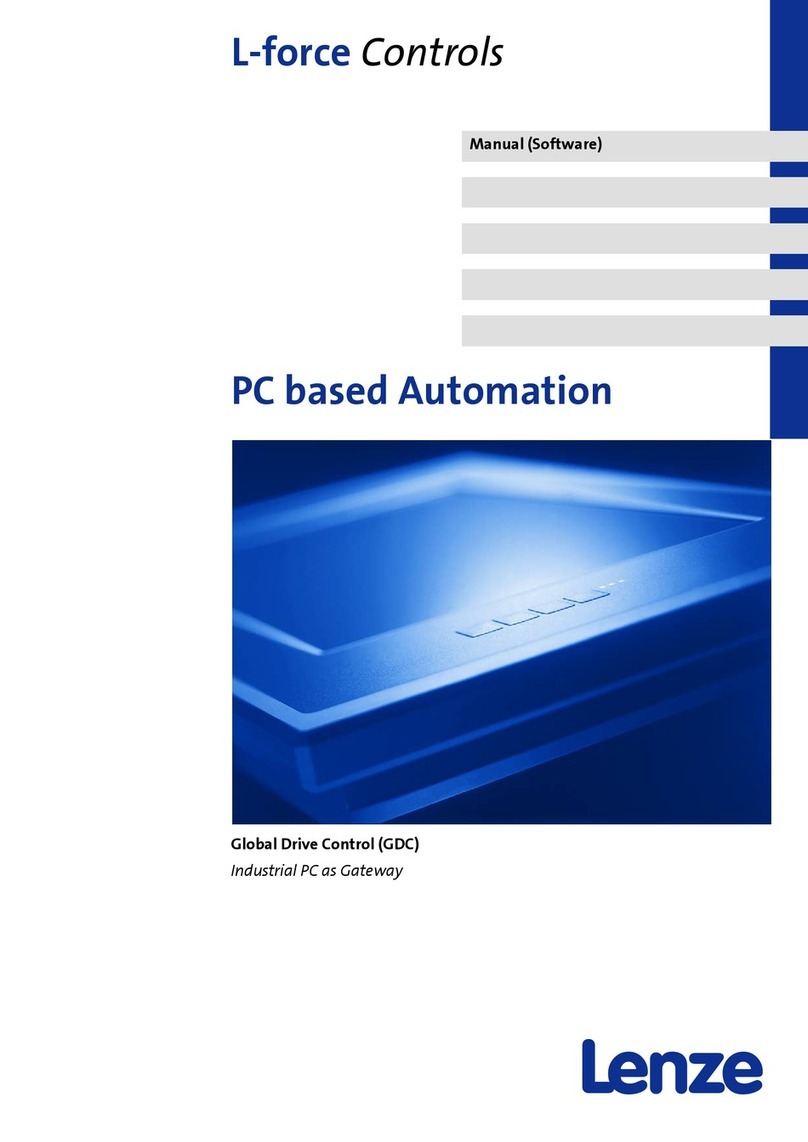
Lenze
Lenze L-force Controls User manual
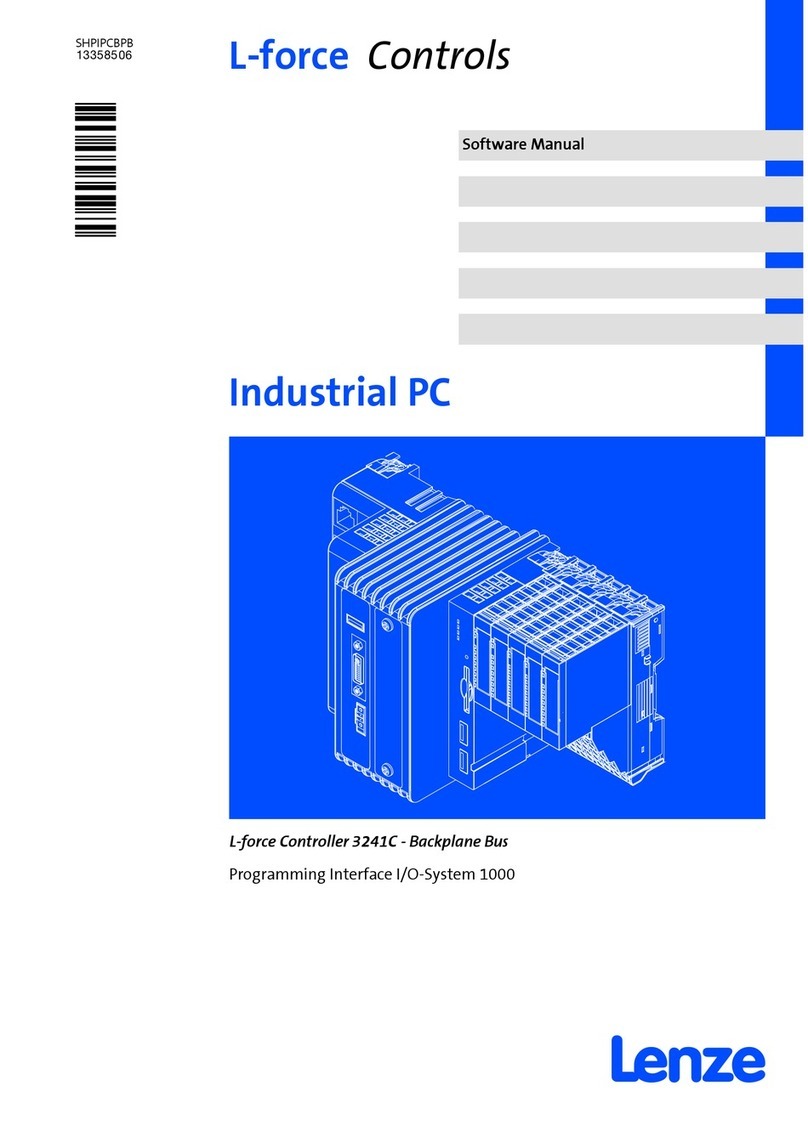
Lenze
Lenze L-Force 3241C Mounting instructions
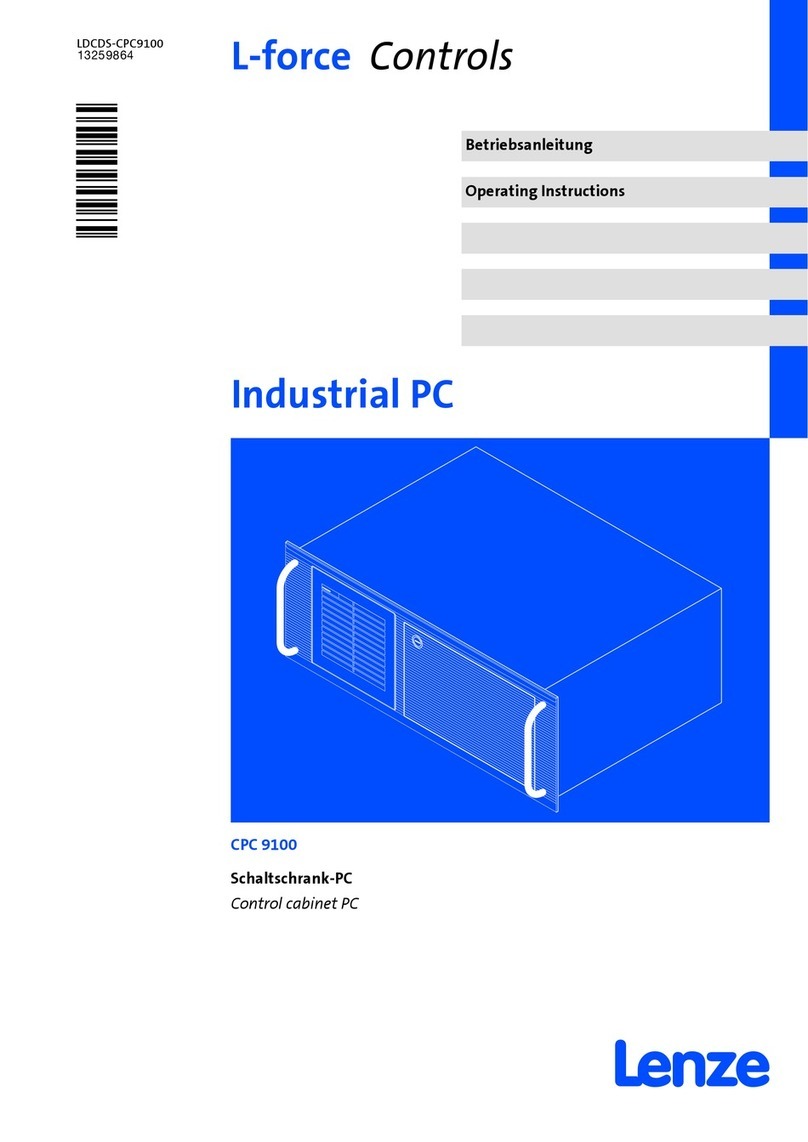
Lenze
Lenze CPC 9100 User manual

Lenze
Lenze L-force Controls User guide
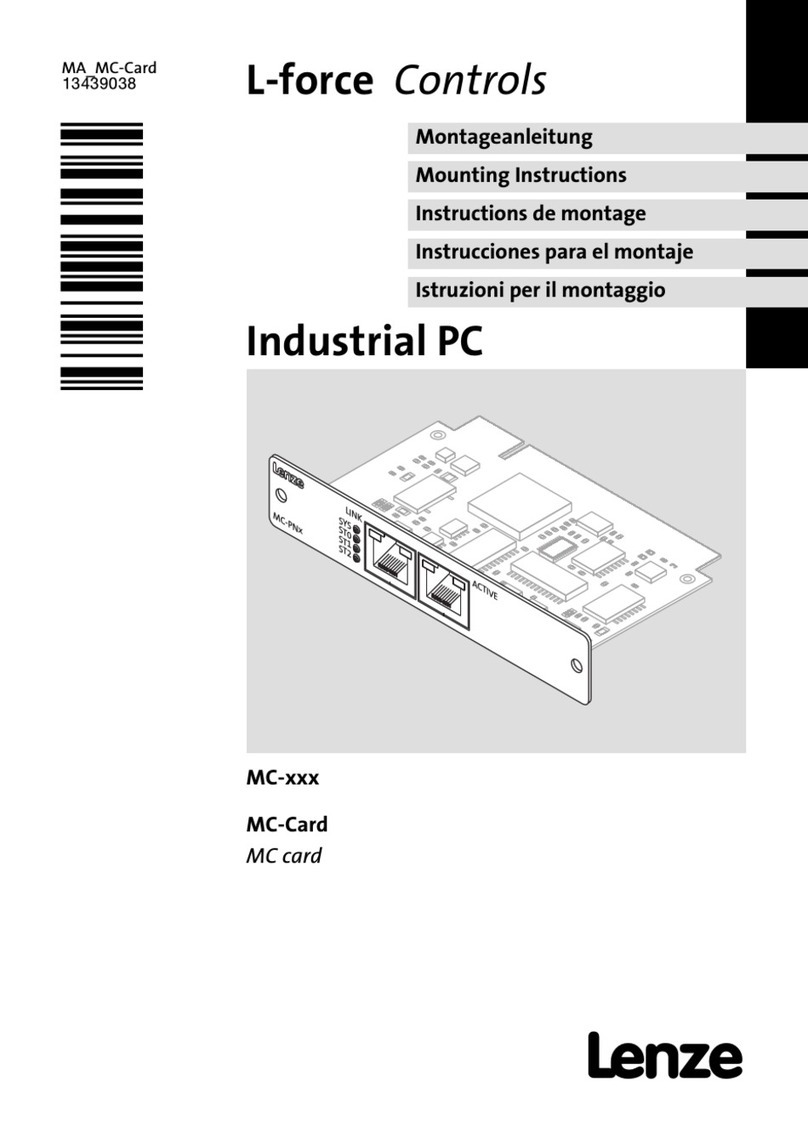
Lenze
Lenze L-force MC Series User manual
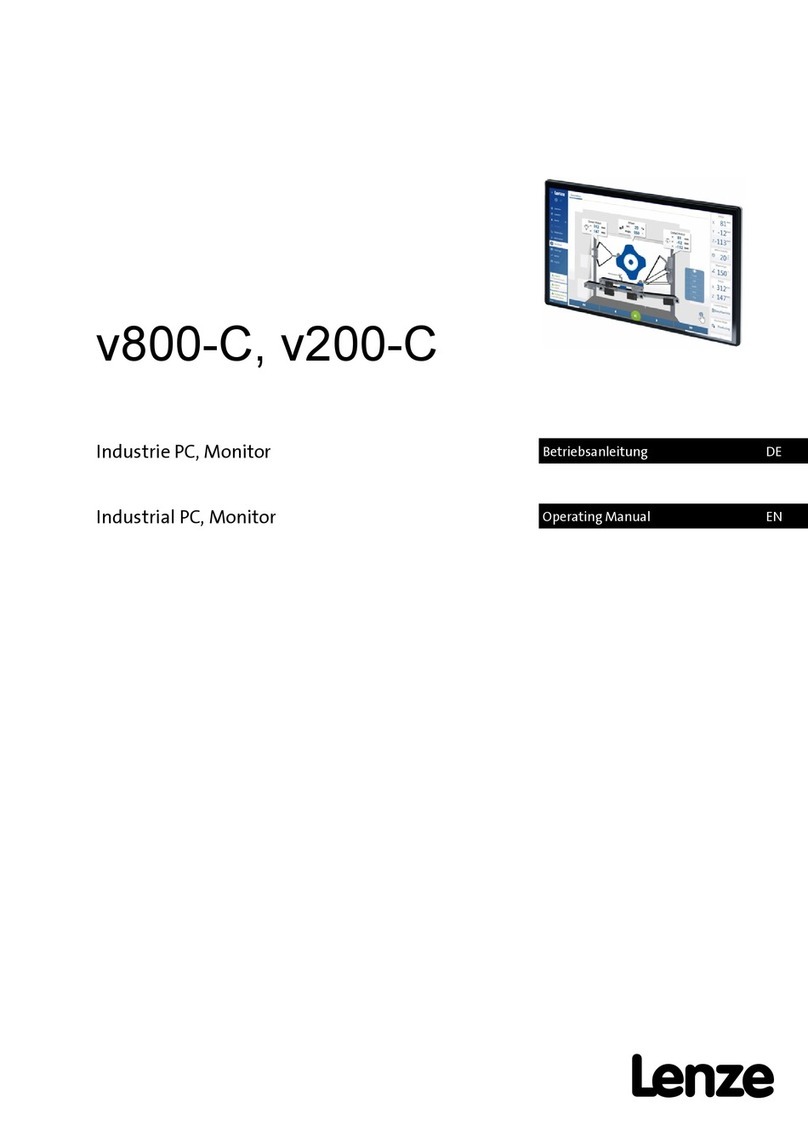
Lenze
Lenze v200-C User manual
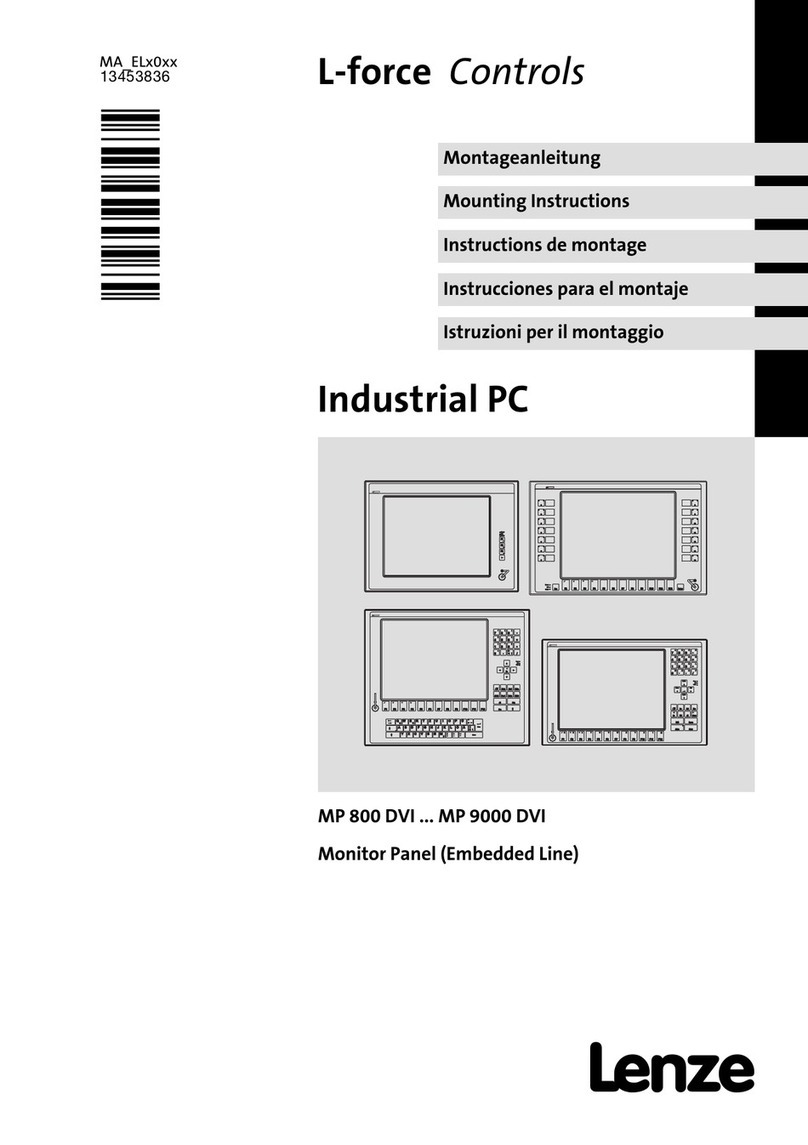
Lenze
Lenze MP 800 DVI User manual

Lenze
Lenze EL 1800 User manual
